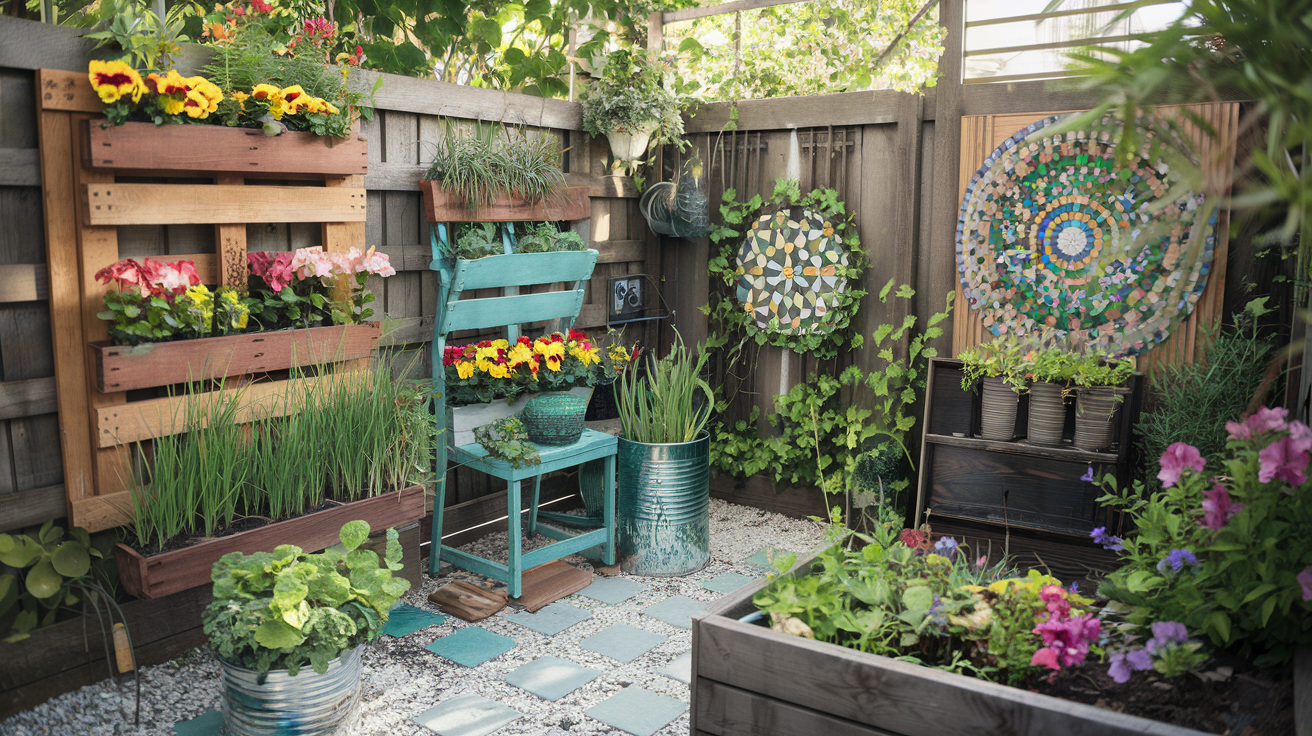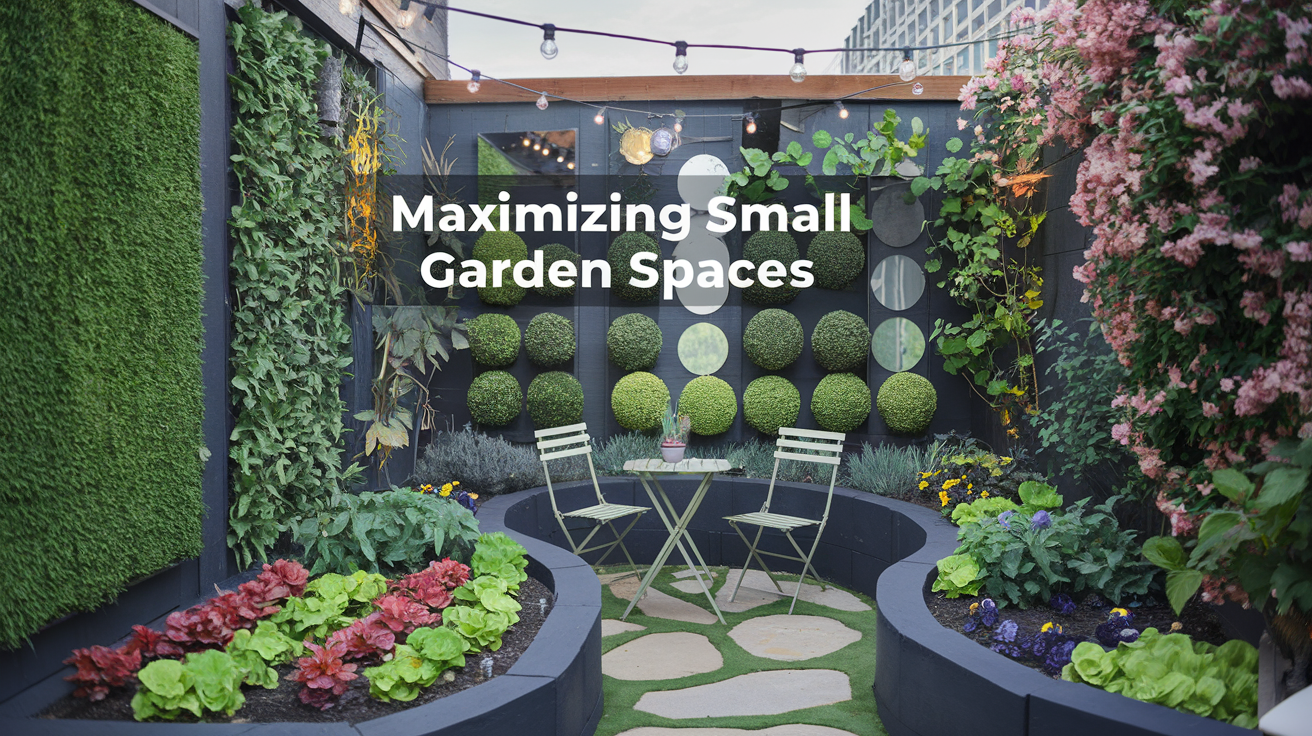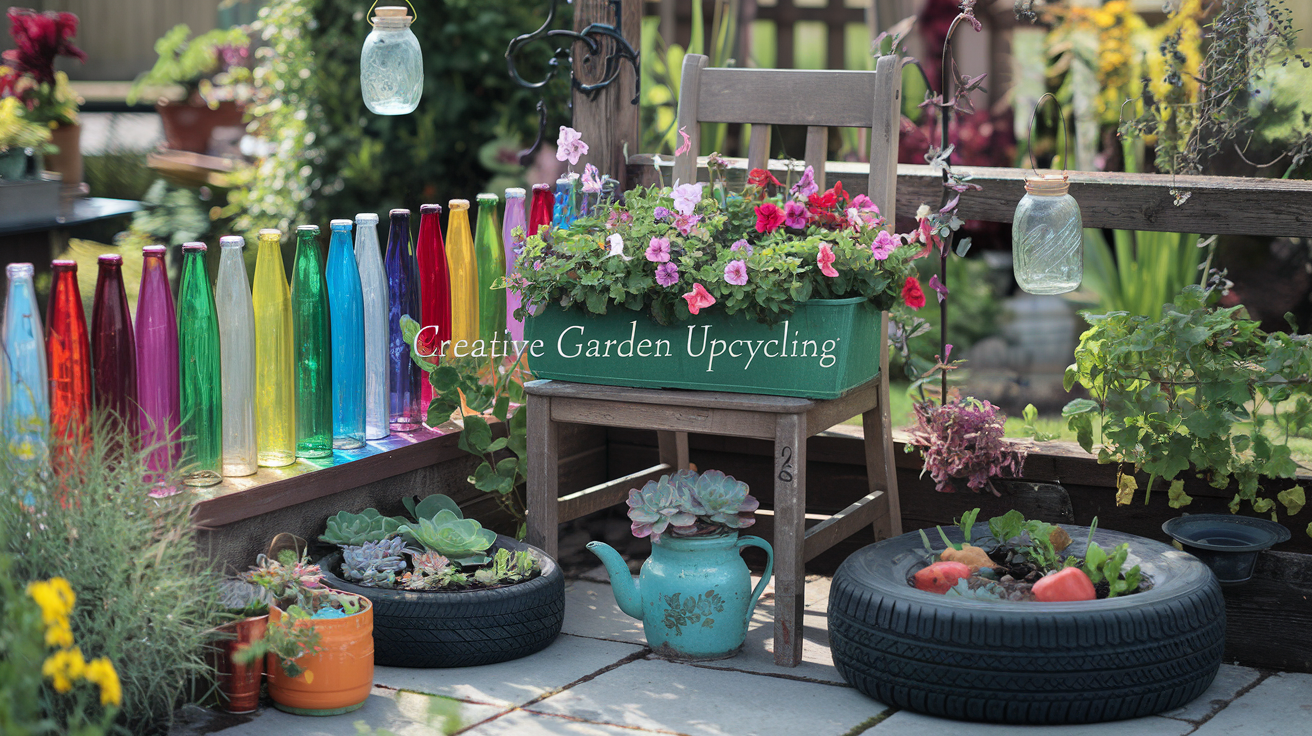15 Unique Gardening Ideas to Try This Season
Have you ever looked at your outdoor space—whether it’s a tiny balcony or sprawling backyard—and felt that creative itch to transform it into something magical? As summer 2025 approaches, there’s never been a better time to roll up your sleeves and dive into the world of DIY gardening. From Jean Mogg Theissen’s stunning wine bottle gazebo in Canada that withstands harsh winters to Faith Rainbow’s enchanting Play Garden in Denver that delights both children and adults, gardeners everywhere are pushing the boundaries of what’s possible with a little imagination and some repurposed materials.
The beauty of modern gardening lies not just in growing plants, but in the creative expression and personal satisfaction that comes from crafting unique spaces. Whether you’re working with a $5 budget for a simple tin can herb planter or investing $50 in a vertical pallet garden, the possibilities are endless—and the benefits extend far beyond aesthetics. DIY gardening offers significant cost savings, positive environmental impact, and proven mental health benefits that we could all use in today’s fast-paced world. 🌱💚
In this comprehensive guide, we’ll explore everything from essential gardening foundations to sustainable approaches that minimize your ecological footprint. You’ll discover how to upcycle everyday items into garden showpieces, maximize limited space with vertical solutions, and create kid-friendly areas that spark wonder and learning. By the time you finish reading, you’ll be equipped with 15 unique gardening ideas that will transform your outdoor space and possibly your outlook on life itself.
Getting Started: Essential Gardening Foundations
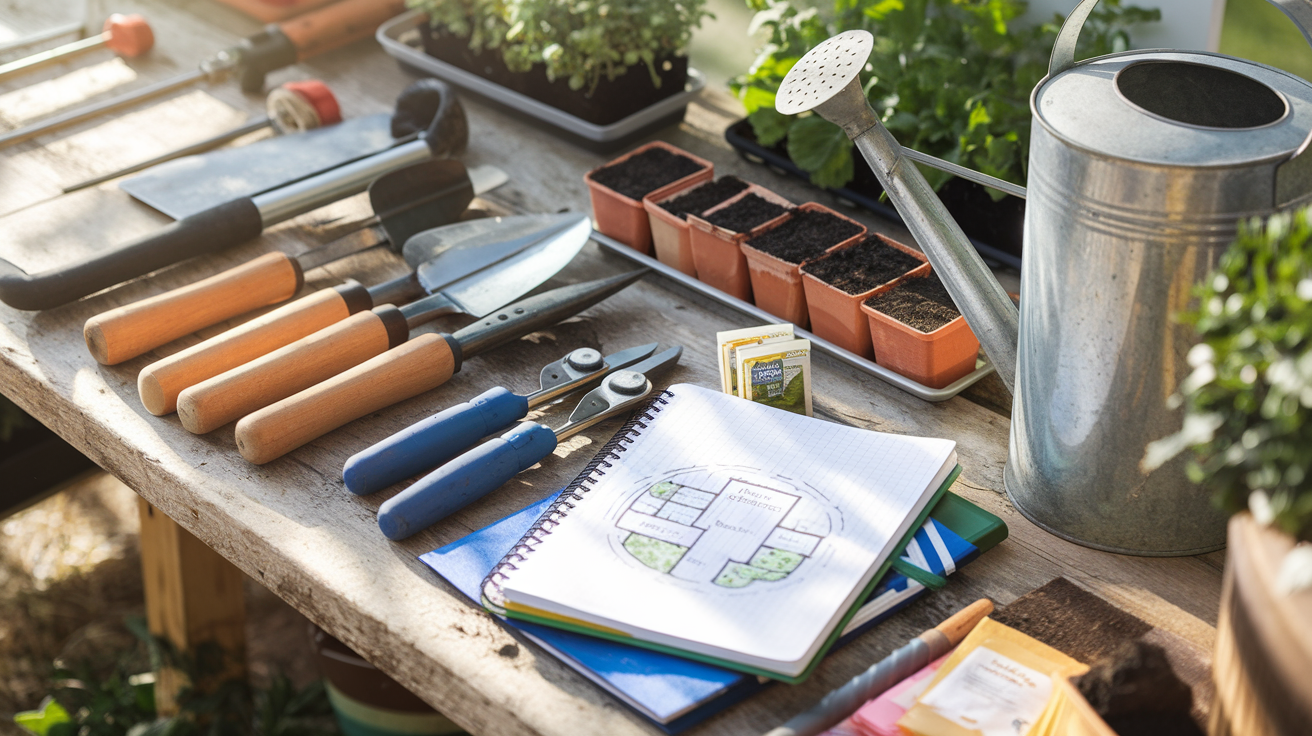
Assessing Your Space: From Balconies to Backyards
One does not require an expansive estate to cultivate enchanting gardens. That tiny balcony? It’s perfect for a vertical herb garden. That patch of concrete behind your apartment? Container garden paradise waiting to happen.
Start by measuring your available space. Be realistic about what will fit. A common rookie mistake is cramming too many plants into a small area, which leads to overcrowding and poor growth.
For balconies and patios:
- Check weight restrictions (soil gets heavy when wet!)
- Consider railing planters to maximize space
- Look up for vertical opportunities (wall gardens, hanging baskets)
For small yards:
- Map out sunny vs. shady spots
- Identify existing features to work around
- Think about traffic flow between plants
For larger backyards:
- Break the space into “rooms” or zones
- Consider focal points (a specimen tree, water feature)
- Plan pathways that make sense for maintenance
The beauty of gardening is that it scales perfectly to whatever space you’ve got. Even a single pot on a windowsill counts!
Understanding Key Factors: Sunlight, Soil, and Climate
The secret garden trio that determines everything: sun, soil, and climate. Get these right, and you’re halfway to garden glory.
Sunlight Assessment:
Track how sunlight moves across your space throughout the day. Most vegetables need 6+ hours of direct sun, while some shade-lovers (hello, hostas!) will crisp up with too much exposure.
Sun patterns change seasonally too. That “full sun” spot in spring might be blazing hot by July. Make notes over a few days to see where the light falls and for how long.
Soil Secrets:
Garden soil is everything. It is not merely dirt—it serves as the living foundation of your garden.
Grab a handful of your soil. Does it:
- Crumble nicely? (Loamy goodness!)
- Stick together like clay? (Drainage issues ahead)
- Feel gritty and dry? (Sandy soil that doesn’t hold water)
Not sure? Soil test kits cost about $10 and tell you pH and basic nutrients. Money well spent.
Climate Reality Check:
Know your hardiness zone, frost dates, and rainfall patterns. That gorgeous plant on Instagram might not survive your winters or summers.
Local weather quirks matter too. Does your area get late spring frosts? Summer droughts? Planning around these realities saves heartbreak later.
Budget-Friendly Tools and Materials
You don’t need to drop a fortune at the garden center to get started. The basics will take you far:
Essential Tools:
- Hand trowel (for planting and weeding)
- Pruners (for harvesting and trimming)
- Watering can or hose with adjustable nozzle
- Garden gloves (protect those hands!)
Skip the fancy gadgets until you know you need them. That asparagus harvester? Maybe wait until you actually grow asparagus.
Clever Cost-Cutting:
- Repurpose household items (yogurt containers make seedling pots)
- Check neighborhood buy-nothing groups for free plants
- Start from seeds instead of buying mature plants
- Make your own compost instead of buying soil amendments
Where to Splurge:
High-quality pruners and a comfortable trowel are worth the investment. You’ll use them constantly, and the cheap ones break quickly.
Safety Considerations for DIY Gardeners
Gardening injuries happen when you least expect them. A little prevention goes a long way.
Protect Your Body:
- Lift with your legs, not your back (that bag of mulch is heavier than it looks)
- Wear gloves when handling soil, thorny plants, or chemicals
- Use knee pads or a garden kneeler for low work
- Take breaks! Gardening is physical work
Sun and Heat Safety:
Garden early morning or evening during hot months. Wear sunscreen, a hat, and keep water nearby. Heat exhaustion sneaks up on you when you’re focused on “just finishing this one bed.”
Tool Safety:
- Keep tools sharp (dull tools require more force and cause more accidents)
- Store pointy tools with blades down
- Never leave tools lying in grass where they can be stepped on
Chemical Caution:
Even organic remedies deserve respect. Read labels, store products properly, and consider if you really need that treatment at all. Many garden problems resolve themselves with patience and healthy plants.
The best safety tip? Listen to your body. That twinge in your wrist is telling you something. Garden smarter, not harder, and you’ll enjoy the process so much more.
Upcycled Garden Projects That Wow
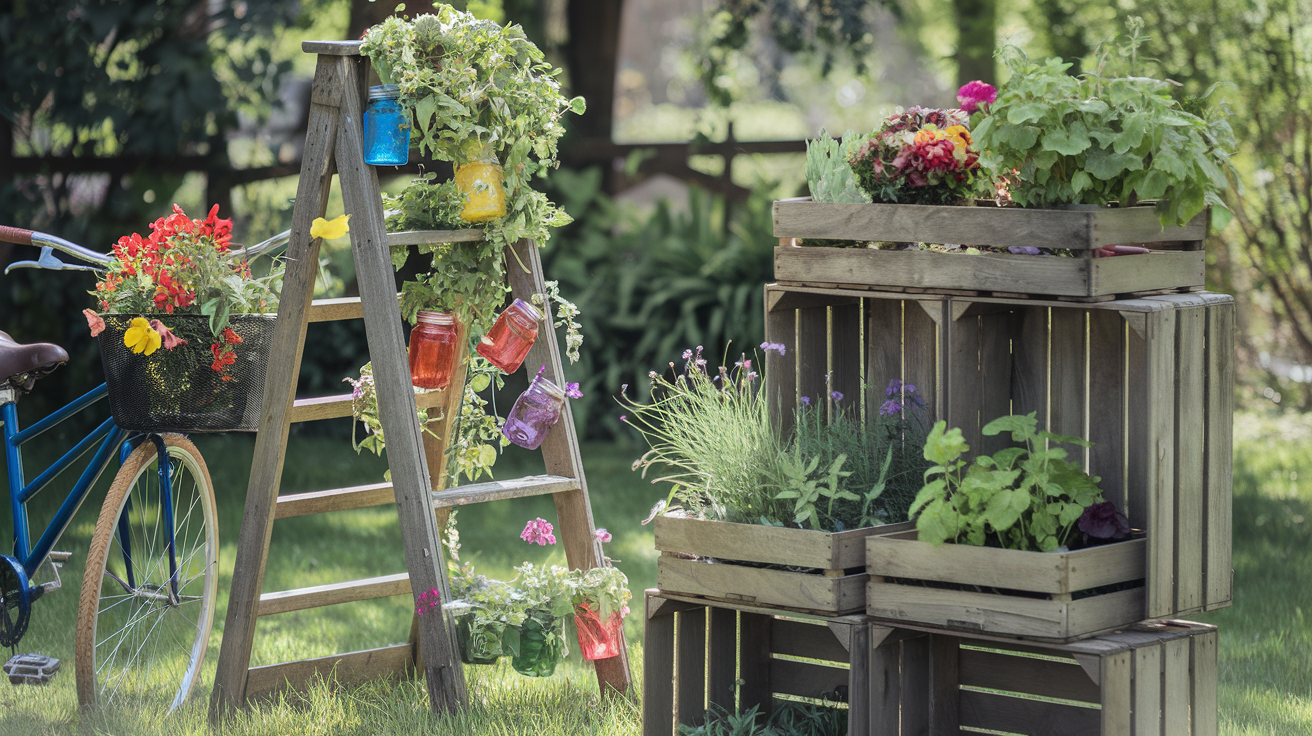
The Wine Bottle Gazebo: Weather-Resistant Beauty
Ever walked past someone’s yard and did a double-take at something so unique you couldn’t believe your eyes? That’s the reaction you’ll get with a wine bottle gazebo.
This isn’t just another Pinterest fail waiting to happen. Wine bottles actually make surprisingly sturdy, weather-resistant building materials when properly incorporated into a structure. Their thick glass withstands rain, sun, and even light hail without losing their vibrant colors.
The magic happens when sunlight filters through the colored glass, creating a stained-glass effect that transforms your garden into a kaleidoscope of dancing light. Blue wine bottles cast cool, calming shadows while amber and green bottles warm up the space with golden and emerald hues.
To build one, you’ll need:
- 50-100 empty wine bottles (finally, a good excuse for that collection!)
- Weather-resistant mortar
- A simple wooden frame
- Patience (this isn’t a weekend project)
Start small with a 4×4 gazebo, inserting bottles horizontally into the mortar between wooden supports. The necks and bases of the bottles should face outward, creating a stunning textured wall that catches light from both directions.
Pro tip: organize bottles by color for a pattern, or mix them randomly for a more eclectic vibe. Either way, your neighbors will be asking for your secret.
Vintage Window Greenhouse: Charm Meets Functionality
Those old windows you spotted at the flea market aren’t just nostalgic wall decorations. They’re greenhouse walls waiting to happen.
Salvaged windows bring character to your garden while serving a practical purpose. Their weathered frames tell stories of houses long gone, while the glass panels trap heat for your tender seedlings.
The beauty of using vintage windows is their ready-made design. Four to six matching windows can be assembled into a box shape, topped with another window at an angle to create the perfect mini greenhouse. Add simple hinges to one panel for an access door, and you’ve got a functional growing space with serious cottage-core appeal.
These greenhouses work especially well for:
- Starting seedlings early in the season
- Growing herbs year-round in milder climates
- Creating a protective environment for delicate plants
Unlike plastic alternatives, vintage window greenhouses age beautifully, developing a patina that only enhances their charm. The divided panes create natural ventilation opportunities, and you can always replace a broken pane without scrapping the entire structure.
Repurposed Door Ideas: From Garden Gates to Decorative Fences
That old door collecting dust in your garage? It’s your garden’s next statement piece.
Vintage doors make striking garden gates, especially when paired with a simple arbor. Their substantial weight means they hang well, and their detailed panels add immediate architectural interest to otherwise plain garden walls.
But don’t stop at gates. Stand several doors side by side, connected with hinges, for a unique garden screen or fence section. Paint them in coordinating colors for a cohesive look, or leave them in various stages of weathered patina for rustic appeal.
One of my favorite door transformations: remove the panels and replace them with chicken wire or decorative metal screens to create a trellis for climbing plants. The door frame provides structure while vines weave through the openings, creating a living wall that changes with the seasons.
Tin Can Herb Planters: Simple Yet Effective
Not every upcycling project requires a workshop full of tools or weeks of planning. Sometimes the most satisfying transformations start with something as humble as your recycling bin.
Clean tin cans make perfect herb planters for kitchen windowsills or patio railings. Their size is ideal for shallow-rooted herbs like basil, thyme, and mint, while their metal construction conducts heat – warming the soil earlier in spring than ceramic pots would.
To transform them:
- Clean thoroughly and remove labels
- Punch drainage holes in the bottom
- Sand any sharp edges
- Apply outdoor paint or leave natural for an industrial look
- Add pebbles at the bottom for drainage
- Fill with potting soil and plant
Arrange them in graduated sizes for visual interest, or group by herb type for a practical kitchen garden. Attach them to pallets for vertical growing, or simply line them up along a sunny windowsill.
Vertical Gardening Solutions for Any Space
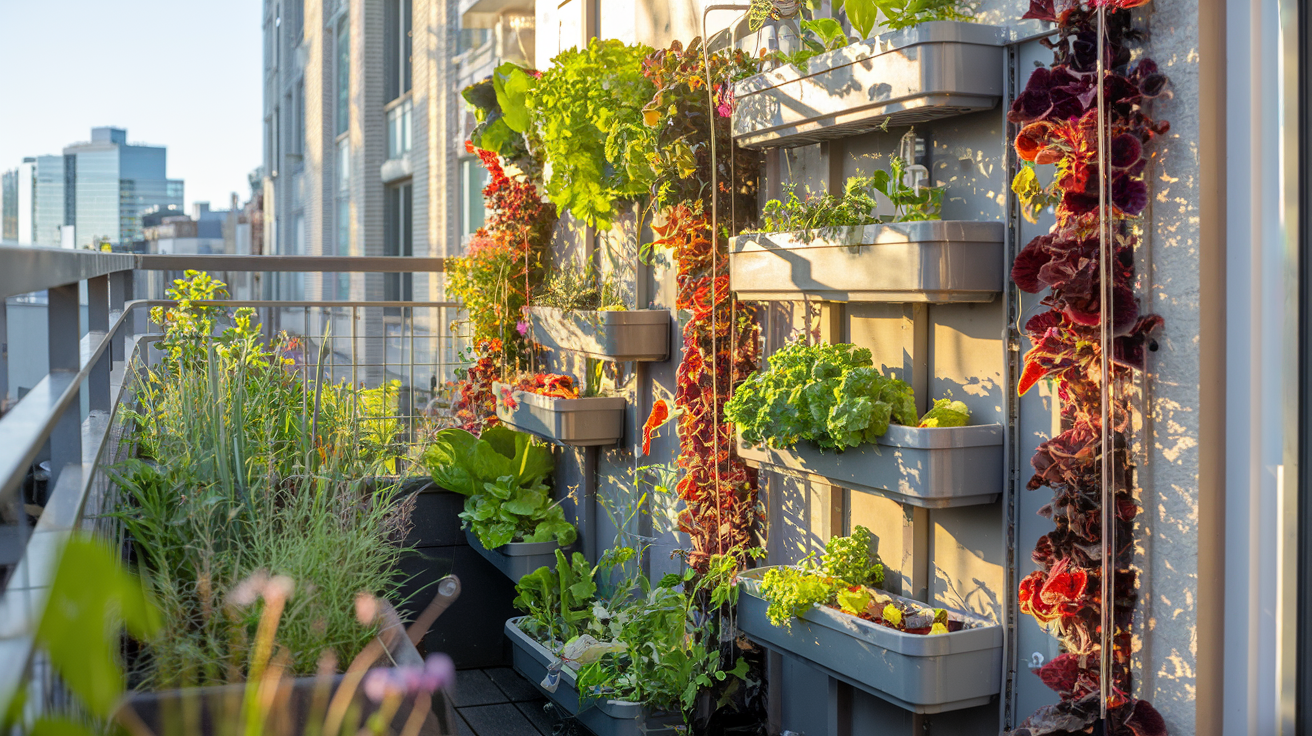
Pallet Gardens: Maximizing Limited Areas
Not everyone has acres of land to play with, but that doesn’t mean you can’t create an impressive garden. Pallet gardens are the ultimate hack for small-space gardening.
Take that old wooden pallet gathering dust in your garage and transform it into a vertical masterpiece. The best part? It costs next to nothing.
Start by sanding down any rough edges (splinters and gardening don’t mix well). Subsequently, incorporate a layer of landscape fabric to retain the soil. You can either stand your pallet upright against a wall or lay it flat while planting, then carefully tilt it upright once your plants have established themselves.
Herbs absolutely thrive in pallet gardens. Imagine stepping onto your tiny balcony to snip fresh basil, thyme, and mint whenever you need them. Strawberries also work surprisingly well – they cascade beautifully between the slats.
The secret to a successful pallet garden? Plan your plant placement based on water needs. Put drought-tolerant plants at the top (they’ll get less water) and thirstier plants at the bottom where moisture naturally flows.
Chair Planters: Furniture Transformed
That old wooden chair with the broken seat? Don’t trash it – it’s garden gold.
Remove the seat (or cut a hole in it), secure a pot or plant directly in the opening, and voilà – instant character for your garden. The chair back creates natural support for climbing plants like jasmine or clematis.
Wooden chairs work best, but metal ones create an interesting industrial vibe when paired with lush greenery. Give them a coat of bright paint – think turquoise, coral, or sunny yellow – to make them real showstoppers.
My neighbor’s rusty old rocking chair became the centerpiece of her garden when she filled it with cascading petunias and sweet potato vine. People literally stop to take pictures of it.
Wall-Mounted Growing Systems
Walls are seriously underutilized garden real estate. A blank fence or exterior wall can become a living tapestry with the right approach.
Pocket planters made from canvas or felt create instant living walls. They’re lightweight and won’t damage your walls like some heavier systems might. Just be sure to waterproof the back to protect your wall surface.
Gutters repurposed as planters work brilliantly for shallow-rooted plants like lettuces and herbs. Mount several rows at different heights, drill drainage holes, and you’ve got an edible wall.
For the tech-savvy gardener, hydroponic wall systems eliminate soil altogether. These systems circulate nutrient-rich water directly to plant roots, making them surprisingly efficient for growing vegetables in limited space.
Space-Saving Hanging Gardens
The area above your head is prime gardening territory when space is tight.
Hanging baskets are classics, but take yours to the next level by planting them with a “thriller, filler, spiller” approach. Include a tall standout plant, bushy middle-layer plants, and trailing varieties that cascade over the edges.
Macramé plant hangers have made a huge comeback, and they’re perfect for showcasing trailing plants like string of pearls or pothos. The texture they add makes simple plants look instantly more interesting.
For something truly unique, try inverted planters for certain vegetables like tomatoes or peppers. These allow plants to grow downward, with gravity pulling the stems down rather than the plant spending energy growing upward.
Artistic Garden Features That Inspire

A. Broken China Mosaics: Creating Lasting Beauty
Remember those old china plates you’ve been saving because they’re too pretty to throw away but too broken to use? Stop hoarding them in your cupboard and turn them into something magical for your garden!
Broken china mosaics are the perfect way to upcycle cracked dishes, vintage teacups, or that plate your mother-in-law gave you that accidentally-on-purpose slipped out of your hands. Oops.
Start small with a stepping stone. Mix some concrete in a mold (even a pizza box works), let it set slightly, then press your broken pieces into a pattern. Leave gaps between pieces for grout later. When it dries, you’ll have a one-of-a-kind garden accent that’ll make your neighbors wonder where you got your amazing taste.
Want something bigger? Try covering a plain terracotta pot with china fragments. The contrast between the earthy pot and delicate porcelain creates something that looks like it belongs in a fancy garden magazine.
Pro tip: Group your pieces by color before you start. Blues and whites create a classic cottage look, while mixed bright colors give you that fun, whimsical vibe.
B. Bowling Pin Pour Projects: Unexpected Art
Who knew those dusty bowling pins from the thrift store could become your garden’s conversation piece? Acrylic pour painting on bowling pins creates the most unusual garden totems you’ve ever seen.
Grab some acrylic paints, silicone oil, and pouring medium. Mix your colors separately, add a drop of silicone oil to create those cool cells, then pour them over a clean bowling pin. The paint will cascade down, creating mesmerizing patterns that look different from every angle.
Once dry, seal with outdoor varnish and mount on a sturdy stake. Plant these colorful creations among greenery or line your garden path with them.
The best part? No two pour projects ever look the same, so your garden art is guaranteed to be original.
C. Carved Wood Accents: Adding Character
Nothing expresses “garden character” quite like handcrafted wooden features. From simple mushroom sculptures to intricate fairy doors attached to trees, wood carvings bring a touch of whimsy and warmth to any outdoor space.
Start with a fallen branch or log and try your hand at simple whittling. Even basic patterns like spirals or geometric shapes transform ordinary wood into something special. Sand smooth, seal with outdoor varnish, and place strategically among your plants.
For the less knife-handy among us, pre-carved wooden masks or panels from craft stores can be weatherproofed and mounted on fences or garden walls. They mature elegantly, gaining a unique character and patina that only serves to heighten their charm.
D. Cowboy Tub Coffee Tables: Function Meets Style
Those galvanized metal cowboy tubs that were once used for washing or holding ice at parties? They make the perfect outdoor coffee tables with a rustic, country charm that’s impossible to resist.
Simply flip the tub upside down for an instant table, or get fancy by adding wooden legs or a base. For extra functionality, attach a wooden top, leaving the tub portion accessible for ice and drinks during garden parties.
Some gardeners take it a step further by cutting a hole in the wooden top and inserting a plastic planter, creating a living coffee table bursting with succulents or seasonal flowers. Talk about a centerpiece that earns its keep!
Kid-Friendly Garden Spaces
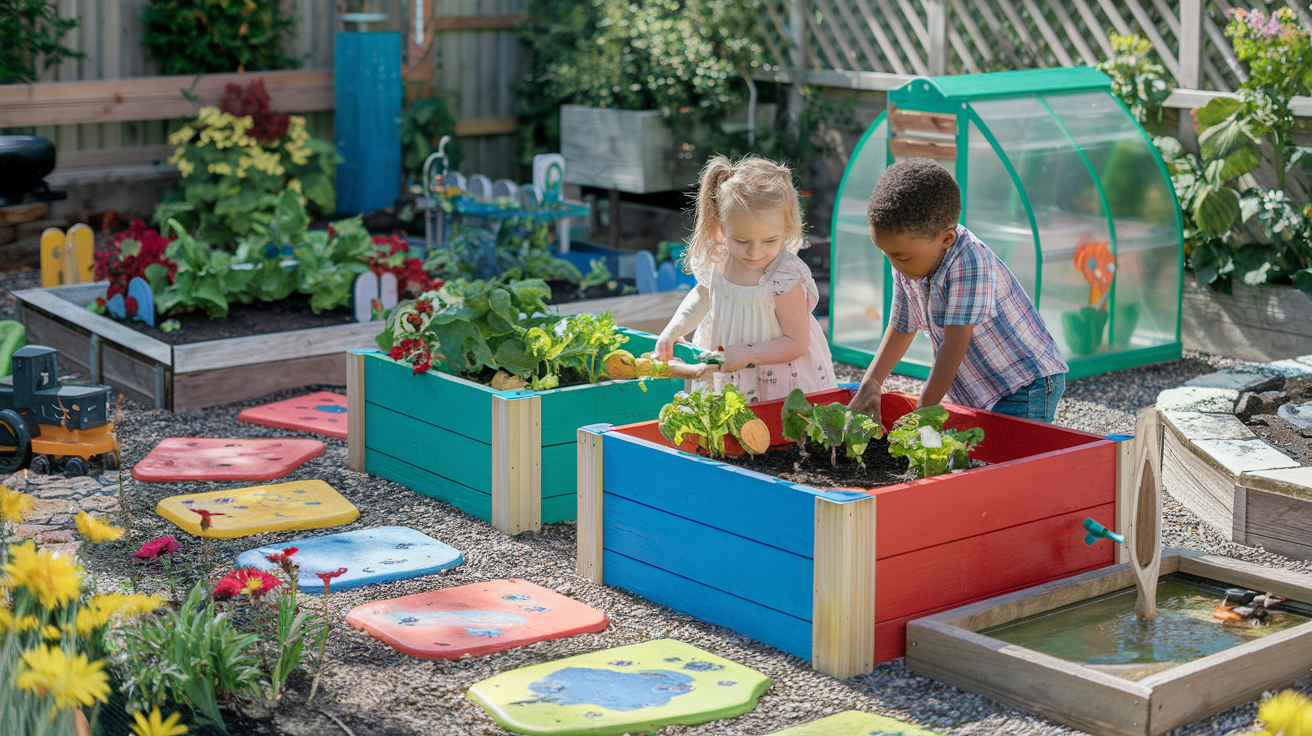
Creating Interactive Play Gardens
Kids go crazy for gardens they can actually play in. It’s not just about looking—it’s about touching, smelling, hiding, and discovering. The best kid-friendly gardens invite exploration without constant “don’t touch that” warnings.
Start with pathways that lead somewhere exciting. Think stepping stones shaped like animals, winding pebble paths, or even a rainbow brick road. Add some mystery with a tunnel made from bent willow branches or a simple teepee structure covered in climbing beans.
Secret hideouts are absolute garden gold for children. A sunflower house (sunflowers planted in a circle) creates a magical space that grows throughout summer. Or go bigger with a living willow dome that becomes more established each year.
Water features? Absolutely! But skip the traditional pond (drowning hazard) and install a shallow stream bed with a hand pump kids can operate themselves. Add smooth stones for splashing and small waterproof toys for imaginative play.
Safe and Engaging Plant Choices for Children
When gardening with kids, plant selection matters—a lot. You need tough plants that can handle enthusiastic “help” while avoiding anything toxic or thorny.
Sensory plants are your best friends here:
- Touch: Lamb’s ear (soft and fuzzy), sensitive plant (folds when touched)
- Smell: Mint, lemon balm, chocolate cosmos, pineapple sage
- Taste: Cherry tomatoes, strawberries, snap peas, nasturtiums (edible flowers)
- Sound: Ornamental grasses that rustle in the breeze, bamboo wind chimes
Avoid common garden plants with toxic parts like foxglove, lily of the valley, and daffodil bulbs. If you’re unsure, check with your local extension office before planting.
Educational Gardening Projects
Kids learn best through hands-on experience, and gardens offer endless opportunities for stealth education.
Create a pizza garden with herbs and vegetables used in pizza toppings. Plant everything in a circle divided into “slices” with stone borders. Each section gets a different topping plant—tomatoes, basil, oregano, peppers.
Butterfly gardens teach about pollinators and life cycles. Incorporate host plants such as milkweed for monarch caterpillars, in addition to nectar plants like zinnias and coneflowers. Add a simple butterfly identification chart.
For older kids, try a weather garden with plants that predict conditions—scarlet pimpernel flowers close before rain, morning glories track the sun, and pinecones open and close with humidity changes.
Colorful Elements That Entice Young Gardeners
Gardens should pop with color when you’re aiming to keep kids interested. Think beyond just flowers to create a space that grabs attention year-round.
Painted garden accessories add instant color. Let kids paint plant markers, stepping stones, or even an old chair that becomes a fairy garden base. Non-toxic outdoor paint works on almost anything.
Incorporate rainbow planting schemes. Try a dedicated rainbow bed with rows of different colored flowers, or create rainbow container gardens using calibrachoa or pansies in graduating colors.
Wind spinners, colorful bird feeders, and child-sized bright tools all keep young ones engaged. Even the garden hose becomes exciting when it’s lime green instead of standard black!
Sustainable Gardening Approaches
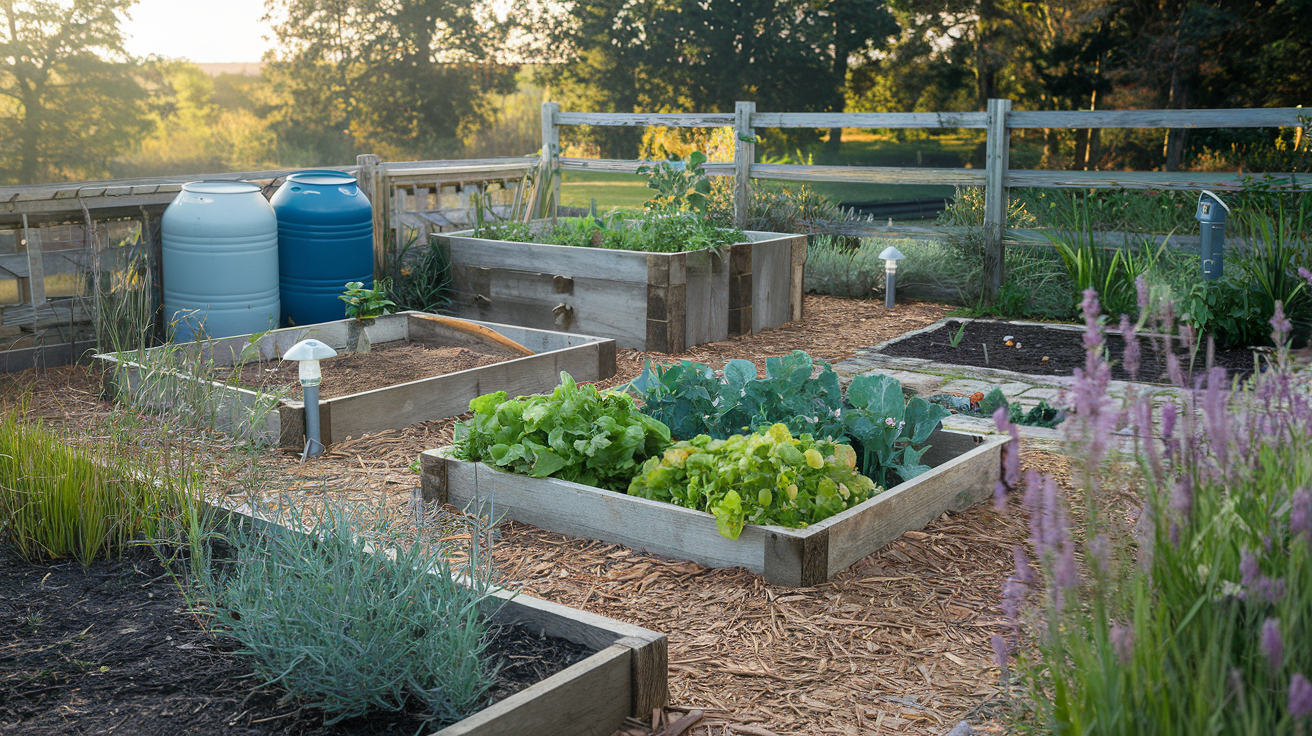
Water Conservation Techniques
You’ve probably noticed that your water bill spikes during gardening season. That’s because traditional gardening can be incredibly thirsty work. However, it is not necessary for it to be this way.
Try installing a rain barrel under your downspouts. A single rainfall can collect 50+ gallons of water that would otherwise just run off into the storm drain. That’s free water for your plants!
Drip irrigation might sound fancy, but it’s actually super simple. These systems deliver water directly to plant roots, using up to 70% less water than sprinklers. No more wasted water on pathways or evaporation into the air.
Mulching is another game-changer. A 2-3 inch layer of organic mulch around your plants dramatically reduces evaporation and keeps the soil moist longer. Plus, it breaks down over time to feed your soil. Win-win!
When to water matters as much as how much. Watering in the early morning (prior to 9 AM) allows plants the opportunity to absorb moisture before the intense sun leads to evaporation. Skip watering in the afternoon heat—most of it just evaporates anyway.
Composting Basics for Garden Health
Your kitchen scraps aren’t trash—they’re garden gold! Composting converts your banana peels and coffee grounds into nutrient-rich soil that plants truly thrive on.
Starting a compost pile is dead simple:
- Find a spot in your yard (shady is best)
- Layer green materials (food scraps, fresh grass clippings) with brown materials (dried leaves, shredded newspaper)
- Keep it as damp as a wrung-out sponge
- Turn it occasionally with a garden fork
The payoff? Rich, dark compost that’s packed with nutrients your plants need. And the best part? You made it for free from stuff you would’ve thrown away.
Not sure what to compost? Here’s a quick guide:
| Yes, Please! | No Thanks |
|---|---|
| Fruit/veggie scraps | Meat or dairy |
| Coffee grounds | Oily foods |
| Eggshells | Pet waste |
| Yard trimmings | Diseased plants |
| Paper products | Treated wood |
Eco-Friendly Pest Management
Chemical pesticides might seem like a quick fix, but they often kill beneficial insects along with the pests. There’s a better way.
Companion planting is nature’s pest control. Marigolds deter nematodes, nasturtiums divert aphids, and basil enhances the flavor of tomatoes while also repelling flies and mosquitoes. Smart planting means fewer pests from the get-go.
For persistent problems, try this DIY insecticidal soap: mix 1 tablespoon of mild dish soap with 1 quart of water in a spray bottle. It works on soft-bodied insects like aphids and spider mites without the harsh chemicals.
Don’t underestimate the power of physical barriers. Floating row covers, copper tape for slugs, and diatomaceous earth create protection without poison.
Using Food-Safe Materials for Edibles
Growing your own food is amazing, but be careful about what touches your edibles.
Those painted or treated wood planters? They have the potential to leach chemicals into your soil, which may ultimately affect your vegetables. For edible gardens, stick with untreated cedar, redwood, or food-grade plastic containers.
When staking tomatoes or other climbing edibles, choose bamboo, untreated wood, or stainless steel options instead of treated wood or random metal that might rust or leach.
Garden hoses often contain lead and phthalates you definitely don’t want in your food. Invest in a drinking-water-safe hose for watering edibles. Your body will thank you.
Even mulch matters. Skip dyed mulches for edible beds—go with natural compost, straw, or leaf mold instead.
Seasonal Gardening Projects
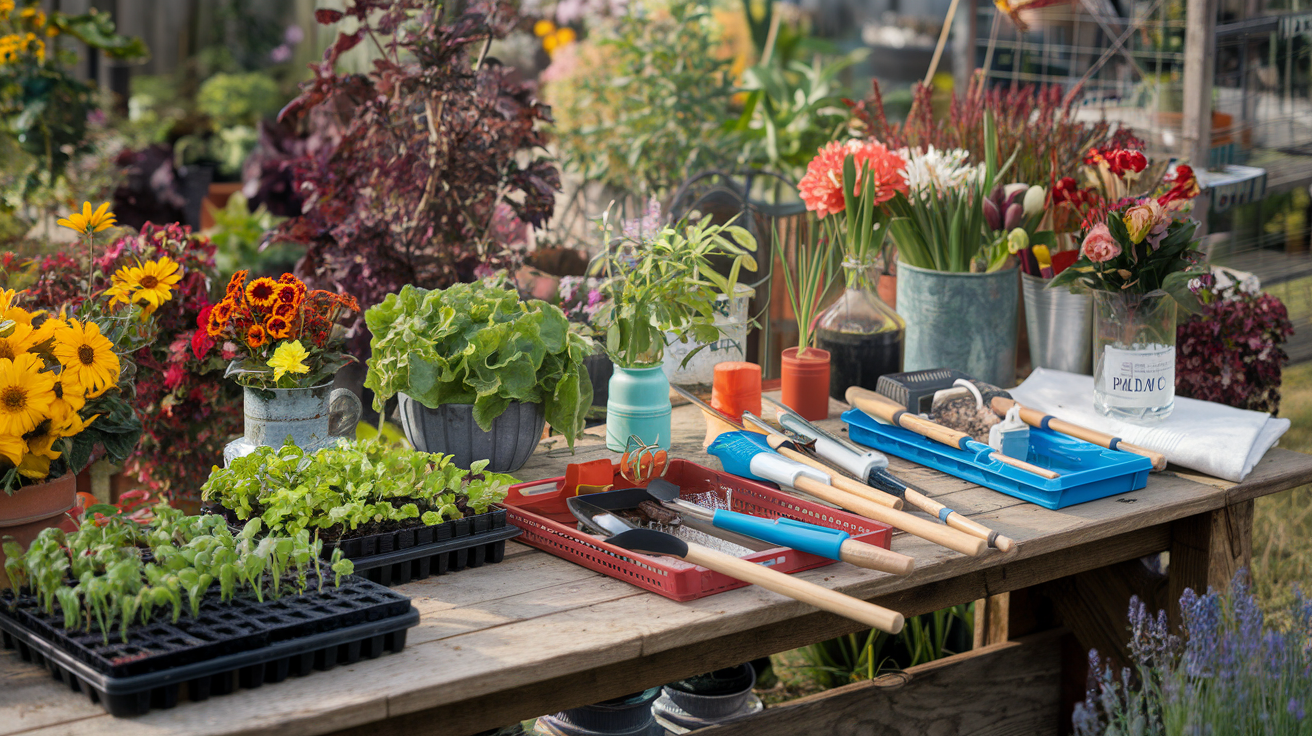
A. Quick Weekend Projects ($5-$20)
Got a free weekend and a few bucks? These garden projects won’t break the bank but will definitely freshen up your outdoor space.
To begin with: establish a small herb garden utilizing repurposed containers. Those pasta sauce jars gathering dust? Clean them, drill drainage holes, paint them fun colors, and boom—you’ve got planters for basil, mint, and rosemary. Total cost: about $8 for soil and seeds.
Another quick win is a DIY bird feeder. Grab a pine cone, slather it with peanut butter, roll it in birdseed, and hang it from a tree branch. Birds will flock to your garden, adding life and natural pest control. Materials run about $6.
For something more structural, build a simple trellis from bamboo stakes and garden twine. It’ll support climbing veggies like cucumbers or flowers like morning glories. This project costs around $15 and takes less than an hour.
B. Investment Projects Worth Your Time ($20-$50)
Ready to level up? These mid-range projects deliver serious garden transformation.
A raised bed garden is game-changing for growing veggies. Using cedar boards (they resist rot) and some basic tools, you can build a 4×4 bed for about $40. The payoff? Years of better drainage, fewer weeds, and higher yields.
Water features sound expensive, but a small solar fountain only costs about $25-35. The gentle bubbling attracts beneficial insects and creates a peaceful atmosphere that makes your garden feel like a retreat.
Consider investing in a rain barrel system. For around $45, you can collect roof runoff and slash your water bill. Most systems pay for themselves within a season, especially in drier climates.
C. Low-Maintenance Options for Busy Gardeners
No time? No problem. These gardening approaches fit even the busiest schedules.
Succulent gardens practically maintain themselves. Create a rock garden with drought-resistant plants like sedums, echeverias, and aloe. They thrive on neglect and still look amazing.
Native plant gardens are another smart choice. Plants that evolved in your region already know how to handle local weather extremes and pests. Once established, they need minimal watering and no fertilizer.
Self-watering containers are worth their weight in gold. These clever pots have water reservoirs that slowly hydrate plants, stretching time between watering to a week or more. Perfect for frequent travelers.
D. Year-Round Garden Planning Tips
Smart gardeners think beyond the current season. Here’s how to stay ahead:
Map your garden’s sun patterns each season. What’s sunny in spring might be shaded by summer. Take photos monthly and note where shadows fall to plan optimal plant placement.
Create a seasonal to-do calendar. Break down gardening tasks by month so you’re never caught off guard. August is when you should start fall crops, while February is seed-starting time for spring.
Practice crop rotation even in small spaces. Don’t plant tomatoes in the same spot year after year. This simple practice prevents soil depletion and reduces pest problems dramatically.
Build a compost system now, even if it’s just a simple bin. You’ll have black gold ready exactly when spring planting demands it. Your future self will thank you when you’re not running to the garden center for overpriced soil amendments.
Creative Container Gardening
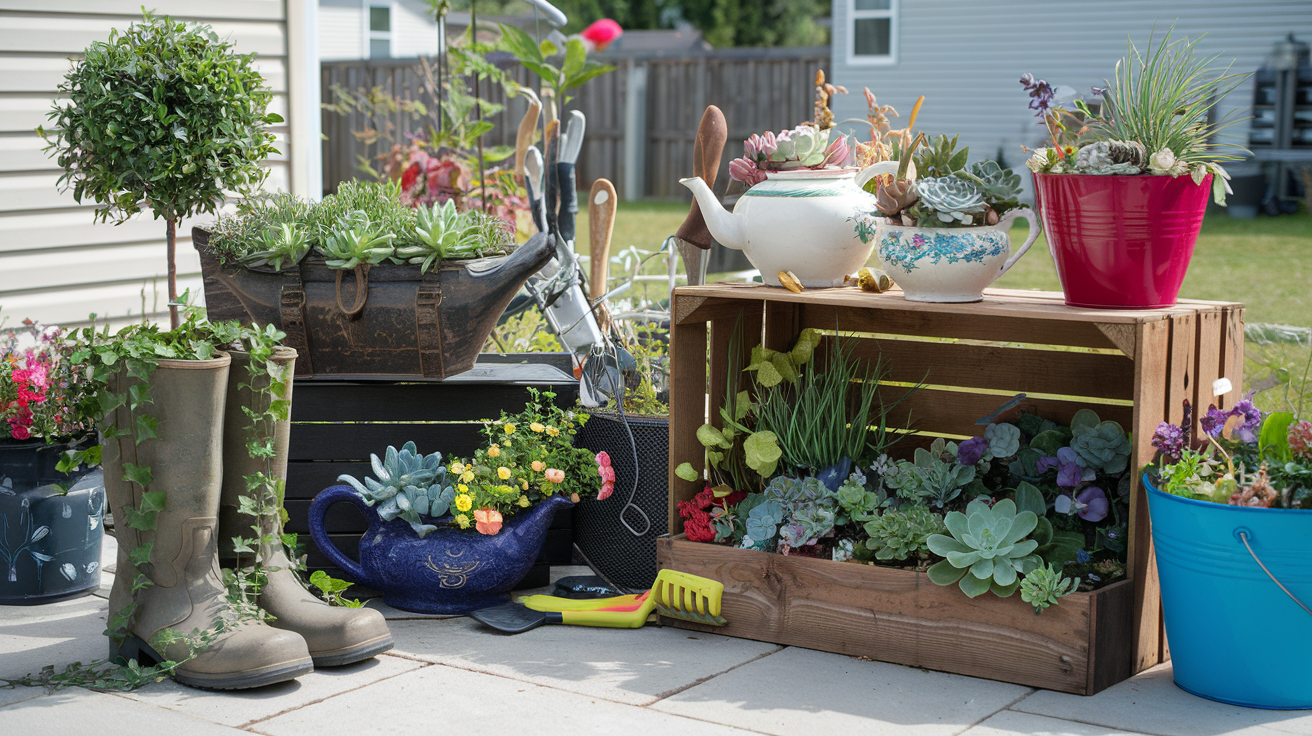
Unconventional Planters That Catch the Eye
Gone are the days when terra cotta pots were your only option. The garden world has exploded with creative container ideas that make your plants pop! Old boots? Absolutely. Vintage suitcases? Why not!
I spotted my neighbor using an ancient typewriter as a succulent holder last week, and I’m still thinking about it. That’s the power of unexpected planters – they become conversation pieces that elevate your garden from “nice” to “wow.”
Some eye-catching options to try:
- Hollowed-out logs or driftwood pieces
- Vintage kitchen items (colanders, teapots, mixing bowls)
- Repurposed furniture drawers
- Metal toolboxes or watering cans
- Children’s toys like wagons or dump trucks
Always keep in mind the fundamental principle: drainage holes are essential. In the absence of adequate drainage, even the most stylish container will turn into a graveyard for plants.
Arranging Container Gardens for Maximum Impact
The secret to container arrangements that stop people in their tracks? It’s all about grouping and contrast.
Instead of spreading containers throughout your space, cluster them in odd numbers (3, 5, 7) to create visual weight. Play with heights by placing some on upturned pots or decorative stands.
Think about color theory too. Want drama? Position complementary colors adjacent to one another (purple alongside yellow, red next to green). Looking for something soothing? Stick with analogous colors that sit next to each other on the color wheel.
And don’t just think plants – mix in garden art, interesting stones, or even mirrors to reflect light and create depth.
Plant Selection for Container Success
Not all plants thrive in containers, but pick the right ones and you’ll have a knockout display all season.
The classic container formula includes three types of plants:
- “Thrillers” – tall, attention-grabbing centerpieces
- “Fillers” – mid-height, bushy plants that add volume
- “Spillers” – trailing plants that cascade over the edges
Plants with similar water and light needs should share containers. Mixing sun-lovers with shade-dwellers is a recipe for disaster – someone’s always going to be unhappy.
Some container superstars include:
| Plant Type | Examples | Container Benefits |
|---|---|---|
| Annuals | Calibrachoa, Coleus, Petunias | Quick growth, constant color |
| Perennials | Coreopsis, Sedum, Hostas | Return yearly, good structure |
| Edibles | Dwarf tomatoes, Herbs, Lettuce | Beautiful AND useful |
| Tropicals | Canna, Elephant Ears, Banana | Dramatic foliage, exotic vibe |
Maintenance Tips for Thriving Potted Gardens
Container gardens need more TLC than in-ground plants. The smaller the pot, the more attention required.
Water is the biggest challenge. During summer heat, containers might need daily watering. The finger test never fails – stick your finger an inch into the soil, and if it’s dry, it’s watering time.
Fertilize regularly but lightly. Container plants are like high-performance athletes – they need constant nutrition since they can’t send roots out searching for nutrients.
Don’t forget to deadhead spent blooms and trim leggy growth. Container plants react significantly to some grooming – similar to a well-executed haircut, it promotes denser, more compact growth.
Lastly, don’t be afraid to swap plants out when they’re past their prime. One advantage of container gardening is flexibility – that spring pansy arrangement can transform into a summer tropical display with minimal effort.
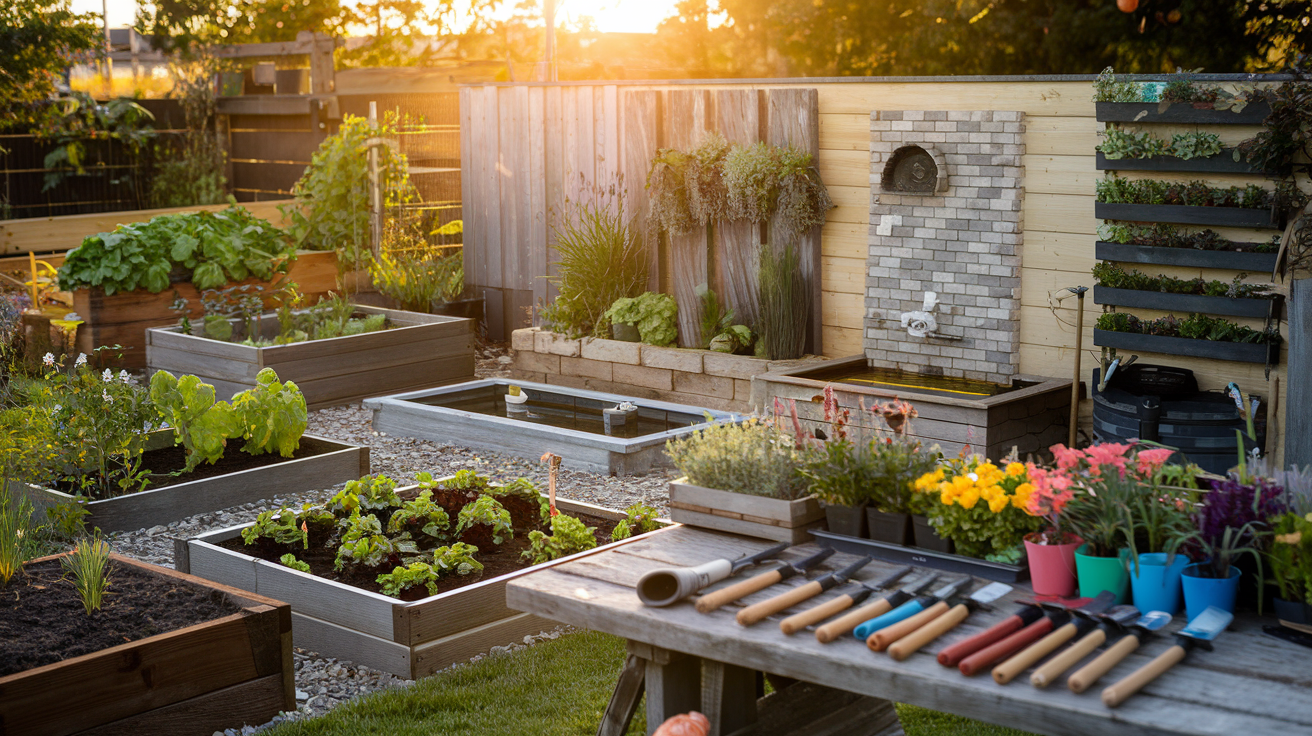
As we’ve explored throughout this guide, gardening offers endless possibilities for creativity and self-expression, regardless of your space or experience level. From the foundational gardening principles to upcycled treasures like Jean Mogg Theissen’s stunning wine bottle gazebo and Veronica Hanson Thompson’s window greenhouse, these 15 unique ideas demonstrate how gardening transcends mere plant cultivation. Whether you’re creating vertical gardens in limited spaces, designing artistic features with broken china mosaics, or building kid-friendly garden spaces like Faith Rainbow’s interactive Play Garden, each project connects us more deeply to nature while expressing our individual style.
We hope these sustainable approaches and seasonal projects have inspired you to transform your own outdoor space this season. Remember, gardening success comes not from perfection but from experimentation and joy in the process. The true reward lies in watching your creative vision take root and flourish. So gather your tools, assess your space, and embark on your gardening journey today. Your unique garden awaits—and we’d love to hear which of these ideas you decide to try first!
15 Unique Gardening Ideas to Try This Season
